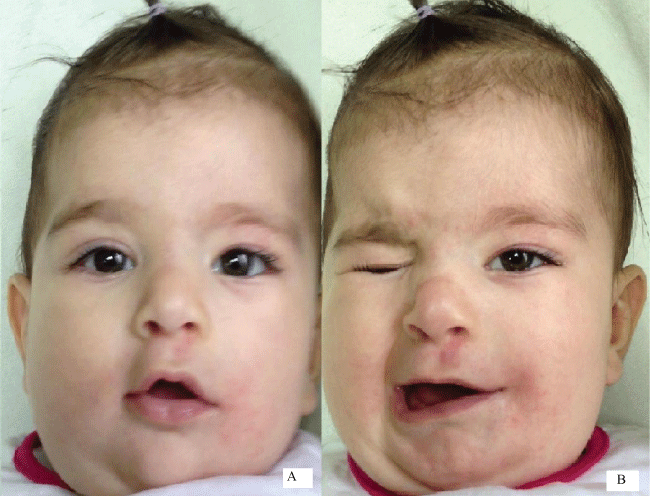International Journal of Brain Disorders and Treatment
Congenital Marin-Amat Syndrome and Asymmetric Crying Face: A Case Report
Arzu Ekici1*, Kursat Bora Çarman2, Özlem Özdemir1, Aynur Küçükçongar3 and Mehmet Ali Ekici4
1Department of Pediatric Neurology, Bursa Şevket Yılmaz Training and Research Hospital, Bursa, Turkey
2Department of Pediatric Neurology, Osmangazi University Medicine Faculty, Eskişehir, Turkey
3Department of Pediatric Metabolism, Bursa Şevket Yılmaz Training and Research Hospital, Bursa, Turkey
4Department of Neurosurgery, Bursa Şevket Yılmaz Training and Research Hospital, Bursa, Turkey
*Corresponding author:
Dr. Arzu Ekici, Department of Pediatric Neurology, Bursa Şevket Yılmaz Training and Research Hospital, Bursa, Akarbaşı Mah. Şehit Zeynel Toköz Sok. Önçağ Park Sitesi C Blok Daire:6, Eskisehir, Turkey, Tel : +90 2222321454, Fax: +90 222 2397437, E-mail: drarzuekici@gmail.com
Int J Brain Disord Treat, IJBDT-2-010, (Volume 2, Issue 1), Case Report; ISSN: 2469-5866
Received: January 07, 2016 | Accepted: March 16, 2016 | Published: March 18, 2016
Citation: Ekici A, Çarman KB, Özdemir Ö, Küçükçongar A, Ekici MA (2016) Congenital Marin-Amat Syndrome and Asymmetric Crying Face: A Case Report. Int J Brain Disord Treat 2:010. 10.23937/2469-5866/1510010
Copyright: © 2016 Ekici A, et al. This is an open-access article distributed under the terms of the Creative Commons Attribution License, which permits unrestricted use, distribution, and reproduction in any medium, provided the original author and source are credited.
Abstract
Marin-Amat syndrome is a rare facial synkinesis and is characterized by the eyelid drooping on jaw opening. It is mostly an acquired phenomenon occurring after peripheral facial paralysis and very rarely congenital. Asymmetrical crying face is a rare minor congenital anomaly, that is the result of unilateral agenesis or hypoplasia of the depressor anguli oris muscle. Our case is the second one in which the onset of Marin-Amat Syndrome is congenital and the first case with asymmetric crying face.
Keywords
Asymmetrical crying face, Congenital, Marin-Amat syndrome
Introduction
Marin-Amat syndrome is a rare facial synkinesis and is characterized by the eyelid drooping on jaw opening. It is mostly an acquired phenomenon occurring after peripheral facial paralysis and very rarely congenital [1,2]. Congenital asymmetric crying facies is a minor congenital anomaly due to absence or hypoplasia of the depressor anguli oris muscle on one side of the mouth. It is frequently associated with other organ anomalies [3,4]. Herein we describe a case of congenital Marin-Amat syndrome and asymmetric crying face (ACF) in a seven month-old girl.
Case Report
A seven month-old girl was admitted to our hospital with the complaint of facial palsy from birth. She was the first child of non-consanguineous parents. She was born following a spontaneous vaginal delivery at term. Past medical history and family history were unremarkable. Her neuromotor development was appropriate for her age.
Abnormal synkinetic movement manifesting with eye closure on jaw opening or during crying were observed while examination. The eye closure occurred only with wide jaw opening. And also the right corner of the mouth went to right and downward while crying. Her face appeared symmetric at rest (Figure 1). Systemic examination was essentially within normal limits.

.
Figure 1: A) Symmetric appearance at rest; B) Synkinetic right eye closure while crying and right-sided asymmetric crying face.
View Figure 1
The results of routine laboratory investigations, thyroid function test, ophthalmologic examination, echocardiography, abdominal ultrasonography and brain magnetic resonance imaging were all normal. Electromyography could not be performed.
Discussion
Asymmetrical crying face is a rare minor congenital anomaly, that is the result of unilateral agenesis or hypoplasia of the depressor anguli oris muscle. Symmetric appearance of the oral aperture and lips at rest, but significant depression of one side of the lower lip with crying is the clinical hallmark. Though it is an isolated finding in most cases, ACF can be associated with other congenital malformations. It may be associated with cardiovascular, musculoskeletal, genitourinary, and respiratory defects [3-5]. In our case, there was no other associated abnormalities except Marin-Amat syndrome.
In Marin-Amat syndrome, except one case reported by Lubkin [6], all cases are acquired. It often occurs after peripheral facial nerve palsies [1,2]. Our case is the second one in which the onset of Marin-Amat Syndrome is congenital and the first case with asymmetric crying face. The exact pathogenesis of both Marin-Amat syndrome and asymmetrical crying face is unclear, some hypotheses have been put forward. It has been reported that agenesis or hypoplasia of the facial muscles is probably of primary origin, but may be secondary, with degeneration resulting from denervation [5]. Marin-Amat syndrome has been suggested to be a result of aberrant re-innervation of the trigeminal and facial nerves [1,2]. We suggest that both congenital Marin-Amat syndrome and asymmetric criying face were due to a common mechanism such as peripheral anastomosis of the facial nerve which have a connection with branches of the maxillary nerve and buccal branches of the mandibular division of the trigeminal nerve. Further studies are required. The other facial synkinesis and Bell's palsy be considered in the differential diagnosis and detailed neurological examination should be performed. If looked for carefully in children with facial nerve palsy, Marin-Amat Syndrome will be diagnosed more often.
References
-
Rana PSV, Wadia RS (1985) The Marin-Amat syndrome: an unusual facial synkinesia. J Neurosurg Psychiatry 48: 939-941.
-
Lai CS, Lu SR, Yang SF, Teh LS, Lee SS (2011) Surgical treatment of the synkinetic eyelid closure in Marin-Amat syndrome. Ann PlastSurg 67: 498-501.
-
Rioja-Mazza D, Lieber E, Kamath V, Kalpatthi R (2005) Asymmetric crying facies: a possible marker for congenital malformations. J Matern Fetal Neonat Med 18: 275-277.
-
Dubnov-Raz G, Merlob P, Geva-Dayan K, Blumenthal D, Finkelstein Y (2007) Increased rate of major birth malformations in infants with neonatal "asymmetric crying face": a hospital-based cohort study. Am J Med Genet A 143: 305-310.
-
Sapin SO, Miller AA, Bass HN (2005) Neonatal asymmetric crying facies: a new look at an old problem. Clin Pediatr (Phila) 44:109-119.
-
Lubkin V (1978) The inverse Marcus Gunn phenomenon. An electromyographie contribution. Arch Neurol 35: 249.





